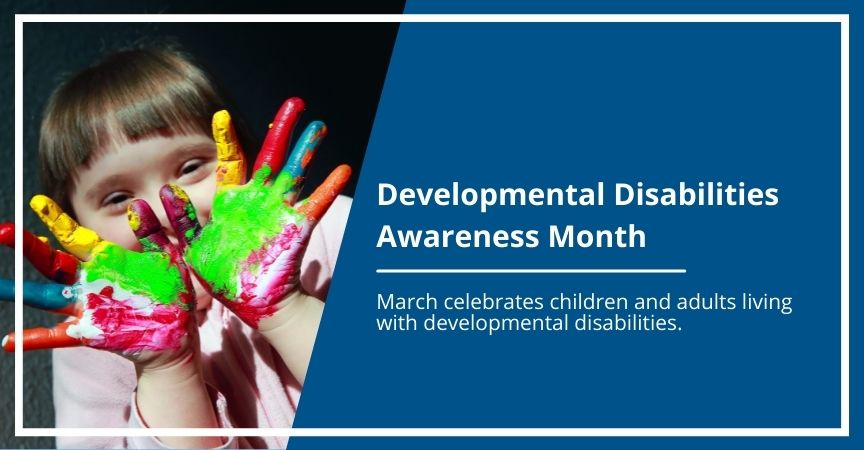Disabilities are far more wide-reaching than most realize. In fact, the CDC reports that about one in four American adults and one in every six children are diagnosed with at least one disability. Visible disabilities such as those that affect mobility or require assistive devices are the most recognized, but only scratch the surface of the disabilities that adults and children experience on a daily basis.
Developmental disabilities are a category of impairments that affect how a child develops, considering both physical and mental growth. There are five types of developmental disabilities, explained below, that can be caused by a variety of environmental factors, medical conditions or procedures, or genetics, and can be difficult to diagnose.
A child develops rapidly in the first five years of life gaining gross and fine motor control, speech and language skills, and social/emotional understanding. Signs of a developmental delay can appear throughout infancy and early childhood but it is not uncommon for disabilities to remain unnoticed until it begins to directly affect education or activities.
March celebrates Developmental Disabilities Awareness Month and Cerebral Palsy Awareness Month in an effort to recognize the challenges that children and families with a diagnosis experience, and develop an awareness of how these conditions should not limit individuals within communities. March 21st is also recognized as World Down Syndrome Day.
Prior to the 1970s and 1980s children and adults with developmental disabilities were often institutionalized because they were deemed incapable of being productive members of society. In many countries, the institutionalization of children with disabilities is still a reality. For decades individuals and organizations have advocated change for children and adults with disabilities, eventually creating equal opportunities in education, employment, medical care, and much more.
The five different types of developmental disabilities affect different areas of growth in a child:
Autism spectrum disorder (ASD), commonly referred to as Autism, is related to brain development and impacts how a person relates and communicates with others, leading to challenges building relationships, holding conversations, or engaging in social interaction. ASD is also associated with rapid and repeated movements or behavior patterns. Spectrum refers to the wide range of symptoms that a child can exhibit, ranging from mild to severe. There is no specific test or cure for ASD, instead, a specialist will ask parents questions about their observations, and interact with the child to identify developmental concerns and potential therapies.
Cerebral palsy (CP) is a disability that affects muscles development, tone, and movement. It is generally caused by damage to the brain before or during birth. The severity of the condition ranges greatly from mild muscle stiffness to severe mobility and joint issues as well as cognitive impairment. Symptoms show during early child development as a child begins to utilize gross and fine motor movements.
Intellectual disability (ID) describes a condition in which a person has a below-average IQ level that impacts their daily well-being. An individual with ID may require significant support to complete basic self-care tasks such as maintaining cleanliness or developing independence. The majority of ID diagnoses show mild symptoms.
Attention deficit hyperactivity disorder (ADHD) is a common disability that affects millions of children who experience symptoms including inattention, difficulty sustaining attention, and impulsive behavior which can lead to trouble in school. It can be difficult to discern the developmentally appropriate behavior of a child from a child with ADHD since children are naturally energetic. Symptoms may surface when the child is school-aged.
Learning disabilities (LD) covers a broad category used to describe intellectual and adaptive functioning which affects conceptual abilities in literacy, reasoning, and memory, social abilities in communication, empathy, and judgment, or practical abilities to complete school or work tasks, manage money or take care of oneself. Learning disabilities are caused by a variety of factors including head trauma during childhood, illnesses, or a genetic syndrome.
Click here to learn more about developmental disabilities, available programs, and resources.
It is important that we maintain a society that embraces our individual differences, and creates even ground for everyone to seek the same opportunities in education, employment, and everyday life. In addition to the Individuals with Disabilities Education Act which makes free public education available and accessible to children with disabilities, the Americans with Disabilities Act prohibits discrimination against individuals with disabilities and provides them protections and equal opportunity when seeking employment, transportation, and other services.
If you believe that your child has been discriminated against in school or work due to their disability please do not hesitate to contact an attorney. Jennifer Chang is a California Special Education Rights attorney who fights for children with special needs to get them the education and services they are entitled to by law.
